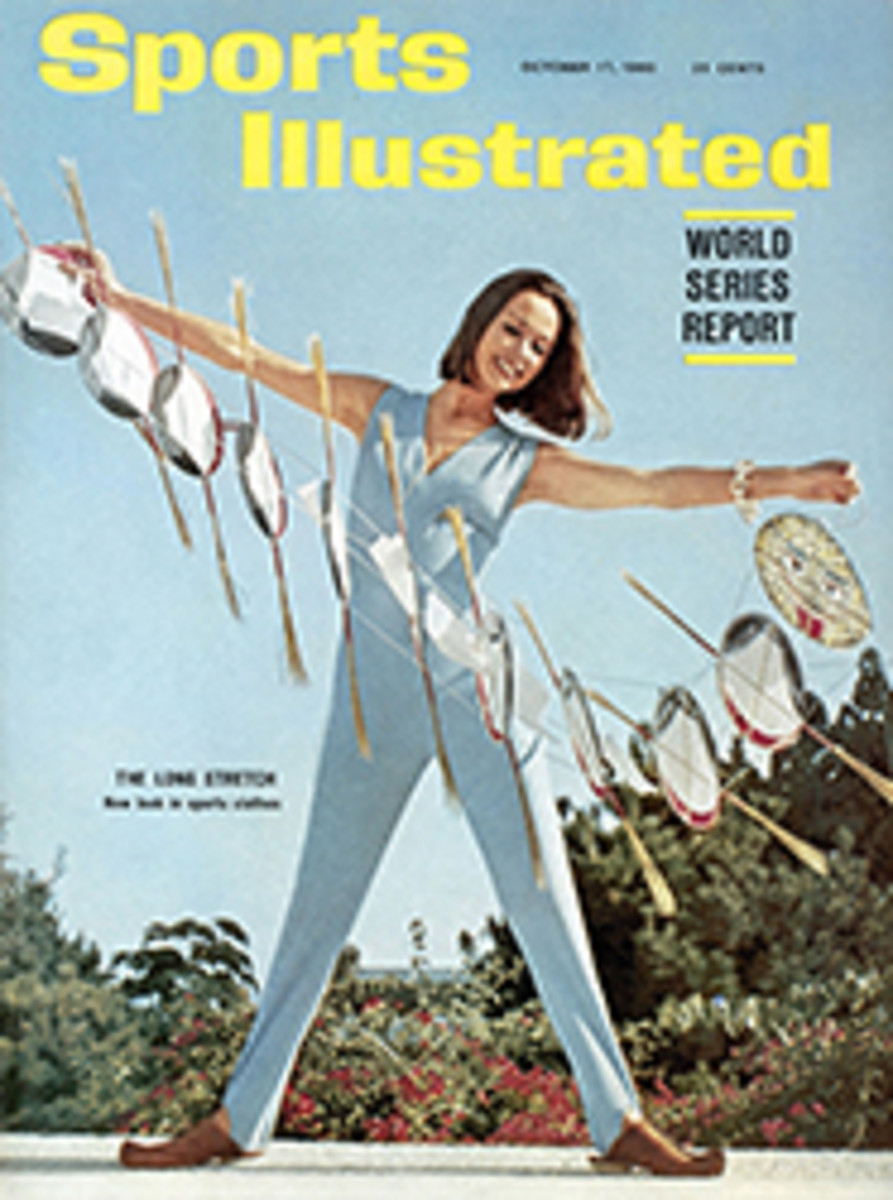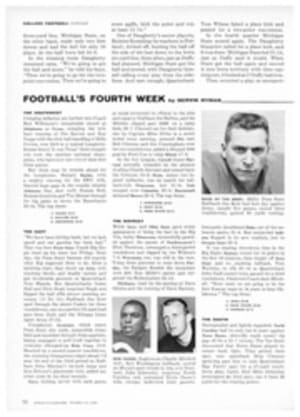
The angry young quarterback
George Shaw is a stocky, sandy-haired young man who has been the second-best quarterback on the two best teams in football for the last four years. He started his pro career as the No. 1 quarterback for the Baltimore Colts, then had the misfortune to suffer a leg injury. His replacement was John Unitas. You might, with very good reason, consider that his second misfortune.
"No one knows how good Johnny is better than I do," Shaw said the other day, en route to Pittsburgh with the New York Giants. "I sat on the bench for two years and watched him. I developed second-stringitis. I began to doubt myself."
Shaw, a serious 26-year-old who is taking an executive training course in a Portland, Ore. bank during the off season, has a bent for self-analysis. When he discovered two years ago that he was suffering from second-class citizenship, he went to Weeb Ewbank, the head coach of the Colts, and asked to be traded to the Giants or to the San Francisco 49ers; Charlie Conerly and Y. A. Tittle even then were two of the oldest quarterbacks in the league.
"I told Weeb that I thought I was damaging myself and the Colts," he said. "When you sit on the bench game after game you find yourself losing interest. I used to go to Weeb and ask him to let me play a little bit just to keep my hand in. You know, go in when we were way ahead. I told him I thought it would be better for the club if Johnny got hurt. But Weeb's theory is go with one quarterback and that's what he did. Johnny's the same age I am and I knew if I stayed with the Colts, I'd spend my life on the bench.
"Weeb and Don Kellett were wonderful," Shaw said. "They made sure I got to the Giants. I've been lucky. I've learned my trade from two of the smartest quarterbacks in the business."
When Shaw came to New York, Allie Sherman, the brilliant young Giant offensive coach, took him aside. "It's up to you, George," he said. "You'll be given every opportunity. But you have to do it yourself. You have to be grim and you have to go into a game with an inner anger. You have to take charge."
In his first year with the Giants, Shaw suffered a severe thumb injury and never was able to play much. This year his thumb is well again and he has assumed the role Don Heinrich used to play as secondary quarterback to Conerly. Shaw had trouble at first learning the Giant numbering system in signal calling, since the Giant and Colt systems are exact opposites.
"I'd be calling the plays left-handed," he said. "The Colts number the holes on one side of the line odd and on the other even and the Giants reversed this. It cost me confidence for a while. I wasn't sure whose signals I was calling. But I've got them right now."
Shaw, after five years as a pro quarterback, still wasn't completely comfortable in the position although he played in most Giant exhibitions this summer.
"When you go in, you feel the responsibility so much," he said. "A couple of years ago, when Johnny was hurt, I played two games at quarterback. I wasn't relaxed and I wasn't confident because I was afraid of playing poorly. Not afraid of giving a bad performance myself, but afraid of failing the team. Maybe I shouldn't say it, but you know when you're out there that the guys up in the line aren't making as much money as the quarterback. When they are great players on a team which is about to win a championship, they demand a lot from a quarterback. They expect you to be as good as they are, or better. It's a big load."
Conerly was unable to play much in the first two Giant games this year because of infected teeth and the burden of quarterbacking fell squarely on Shaw. He squeaked through the first game (a narrow victory over San Francisco) with a relatively undistinguished performance; before the Giants' second game with the St. Louis Cardinals in St. Louis, Sherman needled him. Sherman will not say what he told Shaw but whatever it was it worked.
"He went into the game grim," Sherman said. "He was mad at me and at the Cardinals and at himself. He was an angry young man. This kind of controlled inner anger is a part of being a good quarterback. All the best ones have it. You've seen Bobby Layne cuss out his team for bad blocking. Norm Van Brocklin does the same thing. Conerly is not that effusive, but he gets his point across to the players. The quarterback has to be able to do that. He has to demand and get respect from all the players on the team. He's got to know more than the rest of them. He's a kind of middle ground, above the players and below the coaches. It's a lonely place and no place for a really nice guy. A little anger helps."
The new, angry Shaw passed for four touchdowns in the Giants' 35-14 victory over the Cardinals. On the way to the game in Pittsburgh, he seemed, at last, sure of himself, relaxed and confident.
"I know I'll get to play here," he said. "I'm adjusted to the receivers on this team now. They're great. A quarterback doesn't have much time to look when he drops back; Gifford and Rote and Schnelker run their patterns so well that you know they'll be there when you look for them. The Colt receivers are great, too, but I never threw to them often enough to get adjusted to their styles of running."
Shaw started against the Steelers. He played for most of the first three quarters, and when he left the game the Giants were leading 12-7. He throws a flat pass, harder than the feathery, easy-to-catch Conerly passes, and Giant receivers two or three times dropped the ball when it was on target. Even so, he looked good, and he ran the team crisply and well.
"He made one call I wouldn't have made," Jim Lee Howell, the Giant head coach, said after the game. "We'reahead 12-7, in field-goal range, and he called a pass that was intercepted. A field goal would have been as good as a touchdown. But then he called another play I wouldn't have a little earlier and threw to Rote for a touchdown. The way I look at it is that it's his game while he's in there to run the way he wants to. He's in charge, all the way. If I start sending in plays, I have to send all the plays in and I'm not going to start doing that. You have to give the quarterback authority. It is the only way he can run a team."
When Shaw was taken out of the game, late in the third quarter, it was because Howell thought that Conerly, through his long experience and past superlative performances, would provide a psychological lift for the Giants which Shaw, still a relative newcomer, could not'. Shaw, aware of the reason, was not angry.
Sitting on the bench, he absorbed an object lesson in controlled anger from Conerly. The 39-year-old Giant quarterback, who has worked very little during the last five weeks, was off in his passing. Time and again he overthrew Giant receivers who had worked free behind the rather porous Pittsburgh secondary defense. Each time he left the field, Conerly looked grimmer and angrier. The Steelers' own angry old man—Bobby Layne—passed beautifully to young Buddy Dial for a Steeler touchdown in the third quarter, then herded his team into field-goal range in the fourth to take a 17-12 lead with 7½ minutes to play. Here Conerly, tired and weak and, above all, angry, produced two wonderful, desperate plays. On a fourth down deep in Giant territory, he passed 18 yards to Kyle Rote, who lateraled to Schnelker for another 16. Two plays later, he threw a long, tall pass 44 yards in the air and Frank Gifford, timing his leap perfectly, took the ball between two Steeler defenders and fell over the goal for the winning touchdown.
With Conerly recovering now, it is likely that Shaw will play only a quarter or two a game.
"It's a lot better than it was with the Colts," he said. "I'm beginning to get my confidence back. I think aggressively and positively now." And angrily.
[originallink:10501466:41990]
PHOTO
THE NEW GEORGE SHAW SMILES GRIMLY

